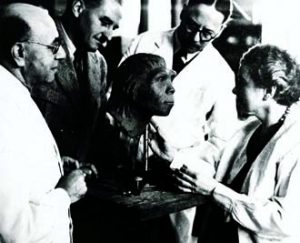
Arnaud Hurel gained a name for himself with the recent publication of a book on the history of his field of study. His volume La France préhistorienne de 1789 à 1941 (Prehistorians’ France from 1789 to 1941) examines this field starting from that paradoxical revolutionary moment when the notion of a “collective heritage [patrimoine collectif]” was invented, even as one wanted to struggle against the signs of the old world. In the case of prehistory, the creation of representations of the very distant past was to accompany the development of knowledge. Here, the author offers us his reflections on these increasingly sophisticated museographical reconstructions, from the life-size dinosaurs of Waterhouse Hawkins shown at the Crystal Palace in 1851 to those of Jurassic Park, and passing by way of the Javanese Pithecanthropus erectus presented by Eugène Dubois in the Dutch India Pavilion at the Paris Universal Exhibition of 1900. Here, as elsewhere, scientists were torn between the duty to admit the gaps in their knowledge and the temptation to make their picks in the great roman à clef of humanity. As for the public, what it cries out for are detailed likenesses that would allow it to believe it knows the truth.
Laurence Bertrand Dorléac
Seminar of March 15th 2008
The Paleoanthropologist and the Artist
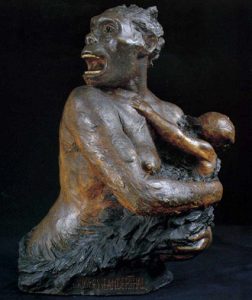
Louis Mascré, supervised by Aimé Rutot, “Woman of the Neanderthal Race. Descendant of prior generations. Mousterian Age,” between 1909 and 1914, Brussels, Royal Institute of the Natural Sciences of Belgium (Vénus et Caïn. Figures de la préhistoire 1830-1930 [Paris: Réunion des Musées Nationaux, 2003]).
Artistic Reconstructions, Science, and Popularization
The study of the history of representations of prehistory in art has provided material for a number of publications and exhibitions. The domain of artistic reconstructions in paleoanthropology is quite interesting from an epistemological, artistic, and historiographical point of view, inasmuch as it is clearly claimed that such works are engaged in a scientifically credible approach.
Whether one is talking about the famous life-size dinosaur reconstructions by Benjamin Waterhouse Hawkins exhibited at the Crystal Palace in 1851 or the Javanese Pithecanthropus erectus presented by Eugène Dubois in the Dutch India Pavilion at the Paris Universal Exhibition of 1900, it can easily be said that reconstructions of fossilized beings for museographical or “pedagogical” ends have been undertaken for a long time. Such activity has historically accompanied the process of recognition of our prehistory.
The basic pitfall faced by those who launch into such an enterprise concerns the lacunary, fragmentary character of the archeological record (in this instance, human skeletal remains), the material itself being, by definition, only what nature and time have deigned to bequeath to the excavator. “Prehistoric man has left us with but truncated messages,” André Leroi-Gourhan wrote. Indeed, fossilization processes are rather unpredictable and complex, and the results of excavations contain a degree of uncertainty. Thus, efforts at reconstruction prove to be quite tricky.
Beyond those difficulties, the perilous character of such efforts also resides in a sort of “genre” change that takes place. The strictly scientific labor of analysis switches location from the enclosed universe of the laboratory, the study, or the inner circle of the scientific community to enter into the public sphere. The researcher thereby agrees, sometimes while having recourse to the services of an artist, to transcribe into physical/material reality what was until then but a theory, a concept, or a scientific abstraction. Such a choice raises questions about the precise nature of this exercise, about its objectives, nay even about whether it is really necessary at all.
One can, in effect, summarize this situation in three cases. First, there is reconstruction as a scientific tool. Here, one starts from some scattered fossil remains in order to reconstruct all or part of an individual (but is a program “scientific” just because it has been announced to be so?). Next, there is reconstruction as a tool for making one’s opinion known to the scientific community or to the public at large. Here, reconstruction is used as a vehicle for the researcher’s personal concepts or as the expression of a paradigm. Then, there is reconstruction as a pedagogical tool. This third tool is used as a museographical aid, a way of popularizing science. Now, if we take quick look back at a few symbolic examples, the image we form is less clear cut, a combination of these hypotheses being the norm, for they do not constitute successive phases but, rather, situations that will be met again for the same object, the same scientist, and during the same period.
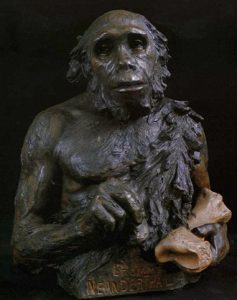
Louis Mascré, supervised by Aimé Rutot, “Man of the Neanderthal race. Descendant of prior generations. Mousterian Age,” between 1909 and 1914, Bruxelles, Royal Institute of the Natural Sciences of Belgium (Vénus et Caïn. Figures de la préhistoire 1830-1930 [Paris: Réunion des Musées Nationaux, 2003]).
Reconstructions “of the primitive human races” by the prehistorian Aimé Rutot and the sculptor Louis Mascré represent a kind of textbook case. Following “attempts” by researchers and artists that had “hardly led to the results their authors had hoped for,” the Rutot-Mascré partnership would lead, between 1916 and 1919, to the completion of fifteen busts. For Rutot, almost all previous reconstructions concerned Neanderthal Man and were limited “to a simple representation of the head, which, at the time, always remained expressionless and lifeless. . . . Either the artists were not adequately informed or guided by men of science or the idea of art had diverted them from the goal at hand.” Because new archeological discoveries–in particular, those made at Spy in 1885-1886 and then at Chapelle-aux-Saints in 1908–allowed one to advance further one’s “knowledge of the original races,” Rutot deemed it necessary to attempt additional artistic reconstructions. Such an exercise seemed to him feasible thanks to his encounter with the sculptor Louis Mascré, “whose mind was haunted by views similar to [his own],” but who “said he lacked the documentary records and advice without which, he said, one would end up only with works of pure fantasy.” The prehistorian contrasts here his scientific rigor with the artist who was dreaming of grandiose scenes, the intention being to illustrate a taxonomy by establishing human types while also breaking with the previous practice of offering “thoughtless and lifeless” heads.
This effort, presented as a “close and ongoing collaboration” between the scientist and the artist, aimed at composing individuals whose posture would reflect one’s “knowledge of the mores, tool use, and weaponry of our ancestors.” Here, “the action of the arms ought to correspond to an idea, and this idea ought to have its exact reflection on the physiognomy of he who executed it.” Rutot repeatedly announced that his was a scientific approach, far removed from any kind of fantasy. Beginning with the “rough reconstruction of the cranial bones of each type,” Mascré established the soft parts of the cranium and then prepared the bust: “Science having received its due, aesthetics reasserts its rights” so as to offer “impressive pictures of real life that are, by way of consequence, ones that are also instructive.” Indeed, Rutot saw in his association with a sculptor the opportunity to go beyond mere anthropological work. The premise was really to “transcribe” into matter his overall concepts and ideas on the phyletic position of this Neanderthal Man, with his quite archaic characteristics, and he went so far as to express moral judgments:
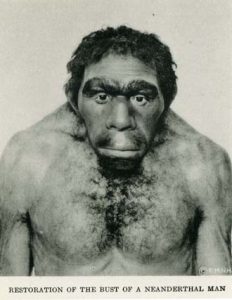
Frederick Blaschke, supervised by Henry Field, “Restoration of the Bust of a Neanderthal Man,” between 1927 and 1929, Chicago, Field Museum of Natural History.
“According to my ideas, which are a result of my studies, I think that Neanderthal Man is the holdover from a race of Humanity’s Precursors, a subjugated race, long since enslaved by other, really human, beings of a higher evolutionary line, whom we know under the name Paleolithic. These final descendants of an ancient race that still resembles animals and has been reduced to slavery, lived with their master in shared caves. The master gave the orders, the slave obeyed. The master told the slave to break a long bone of an ox so as to be able to extract the marrow–an operation repeated daily during the era in question–and the apelike slave, with his lackluster eyes and timorous, submissive expression, his stone hammer in hand, would bend down to break the bone.”
Reconstruction as Concession to the Need for the Popularization of Science
The presentation of these busts obviously was going to elicit curiosity but also disapproval, nay even an ironic response, as when Marcellin Boule, Professor of Paleontology at the French National Museum of Natural History, published a biting critique of what he called “audacious reconstructions of human fossils”:
“The critic is disarmed before such a work when it is presented under the auspices of a man of science. All anatomists and all anthropologists who know the difficulties involved in attempts of this kind, even when one is in possession of complete and perfectly preserved osteological records, can only smile at the boldness of Monsieur Rutot, whose extraordinary imagination very readily makes up for the lack of accurate information. It is our duty, nevertheless, to protest, for such undertakings, as pleasing as they may appear in certain respects, are of such a nature as to cast discredit upon a science that is still having so much trouble gaining acceptance in official circles and that does not deserve to be distorted in this fashion.”
The case of the representations of Neanderthals is rather emblematic. In the early years following the discovery, in 1856, of human remains in the Neander valley, a number of attempts at reconstruction were made. True, the skeletal remains of “Mousterian man” were of intense interest to scientists and fascinated the public at large, the popular dailies opening wide their columns for each of these discoveries. Such success even led some skeptics, like Professor Boule, to revise their positions.
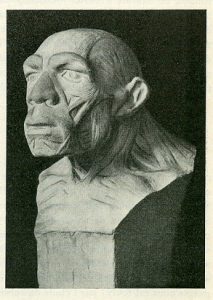
Joanny Durand, supervised by Marcellin Boule, “Reconstitution of the Head and Neck Muscles of the Homo neandertalensis of Chapelle-aux-Saints,” 1921 (M. Boule, Les hommes fossiles [Paris: Masson, 1921]).
Boule’s name is indissociably linked to the study of the first near-complete Neanderthalian skeleton. It was in August 1908 that Fathers Jean and Amédée Bouyssonie, their brother Paul, and their friend Father Louis Bardon, brought to light some fossilized remains at Chapelle-aux-Saints (in the Corrèze department of France). All these bones were entrusted to Boule, who then devoted himself to a long and meticulous effort at reconstruction (some of the bones were broken, including the skull which was shattered into some thirty fragments) and analysis. He published his results in a monograph, where he posed as a “simple translator of observed facts.” This monograph was to become a reference work for generations of anthropologists and would, in part, orient thinking about Neanderthal Man. In 1919, following a lecture during which the paleontologist presented his research, the sculptor-engraver Joanny Durand wrote to Boule to announce to him that “there exists in Paris a man of a certain age who offers all the characteristics of the apelike race: short necked and very muscular, bow legs, stooped walk, very long forearms naturally falling completely prone, the elbows far removed from the torso, the skull carina-shaped, very prominent arch of the eyebrow, very large nose, exaggerated prognathism of the lower jaw, etc.” And this individual was Auguste Rodin’s model for his “Thinker” in “The Gates of Hell.” Responding to public expectations, Boule would call upon the talents of Durand to execute in turn, in 1921, a reconstruction that would be featured in his handbook of human paleontology: “Can one go further and recapture his physique, presenting a lifelike portrait of Neanderthal Man? Everything is allowed to artists, who can, without any disadvantage, seek to produce to great effect original works of the imagination. Men of science–and of conscience–know too well the difficulties involved in such attempts to see therein anything other than a recreational pastime.” Wishing to escape “vulgar popularization,” he had a cutaway bust done, which he deemed so close to reality that it “affords [everyone] the opportunity to study this physiognomy, to rediscover therein the morphology of the skull, to compare it to the faces of Men today, and to ask oneself what a covering in skin and hair as well as a more or less dramatic set of muscles represented here in a state of rest could add to the expression of this physiognomy.”
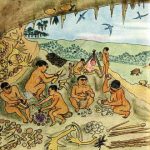
Henri Breuil, « The Hunters’ return at Chou-Kou-Tien », 1945 (H. Breuil, Beyond the bounds of history, London, P.R. Gawthorn, 1949)
In China, too, new discoveries of human fossils were an occasion to indulge in exercises in reconstruction. The revelation, between 1927 and 1937, at Zhoukoudian (about thirty-five miles from Beijing) of the remains of a Homo erectus (Sinanthropus pekinensis) was a major scientific event. Franz Weidenreich, the anthropologist charged with providing an expert opinion, settled down to the task of reconstruction, starting with a cranium and a few facial elements. Weidenreich’s objective was clearly to reconstruct a “typical” fossil, the Sinanthropus “type.” Once again, a scientist was going to use this operation as a vehicle for displaying his own ideas. He chose, for example, to reconstruct a female of the species (even though the bones he had at his disposal did not allow one to deduce from them such slender features), and he heightened the expression of archaic (simian) characteristics while bringing out present-day Asiatic traits. He thus accented an idea of continuity, which allowed his theory of the local (multiregional) evolution of modern men to be reinforced.
The new Peking Man, which made its entrance on the scientific stage in 1926 under the soubriquet “Peking’s Lady,” acquired a face (a bust executed by the sculptress Lucille Swan) and a name (Nelly) ten years later with the international team that worked on the reconstruction.

Lucille Swann, supervised by Franz Weidenreich, “Nelly” (Sinanthropus pekinensis), 1937 (Teilhard de Chardin Foundation photo).
Each Reconstruction Is Said to Be an “Extended Roman à Clef”
Today, new technologies (medical scanners and 3D imaging software) daily accompany the research work of a good number of paleoanthropologists. Description, analysis, and reconstruction now form a coherent whole and constitute the successive stages of an effort whose goals are above all scientific. But these researchers are still faced with questions close to those of their predecessors, while also including other critical features, among them those tied up with technological issues (like the anthropologist’s ability to have full “control” over ever more advanced computer tools).
Obviously, the exercise involved in reconstructing human fossils represents in itself an epistemological kind of case. As a way of popularizing science, it seems to betray an imperfect scientific and artistic act, an operation involving communication/mediation, either explicitly championed or ill-assumed. Questioned on this topic, Ian Tattersall (of the American Museum of Natural History) judges that what a reconstruction boils down to is “giving life to bones,” that is to say, making eventual concessions to the necessities of popularization with a view toward enabling the public at large to appropriate scientific progress for itself. Yet, according to him, the challenge remains that, in a museographical presentation, what the public is attracted by are all those features scientists are in reality incapable of providing (like the color of the eyes or the skin, the question of hair growth).
In short, to borrow a phrase from Stephen Jay Gould apropos of the dinosaurs in the film Jurassic Park, each of these reconstructions may be regarded as an “extended roman à clef” in which the inventor’s own ideas shine through[ref] Stephen Jay Gould, Dinosaur in a Haystack: Reflections in Natural History (New York: Harmony books, 1995), p. 230.[/ref]. What is apparent is that, whatever one’s objective may be and whatever tools one may use, reconstructing an individual on the basis of fossilized remains–which are by nature incomplete–is itself a powerful act: it involves taking sides, making a choice, and, to a certain extent, it is an act involving both conviction and persuasion.
Bibliography
Boule, Marcellin. “L’Homme fossile de la Chapelle-aux-Saints.” Annales de Paléontologie, 6-7-8 (1911-1912-1913): 109-72, 105-92, and 1-72.
______. “Audacieuses reconstitutions d’hommes fossiles.” L’Anthropologie, 26 (1915): 183-84.
______. Les Hommes fossiles. Éléments de Paléontologie Humaine. Paris: Masson, 1921.
Gould, Stephen Jay. Dinosaur in a Haystack: Reflections in Natural History. New York: Harmony Books, 1995.
Hurel, Arnaud. “La découverte de l’Homme fossile de la Chapelle-aux-Saints (1908). Pratiques de terrain, débats et représentations des Néandertaliens.” Organon, 34 (2005): 97-118.
Leroi-Gourhan, André. Les religions de la préhistoire. Paris: Presses Universitaires de France, 1964.
Rutot, Aimé. “Un essai de reconstitution plastique des races humaines primitives.” Mémoire de l’Académie royale de Belgique. Classe des beaux-arts, 2nd series, 1 (1919).
Tattersall, Ian and G. J. Sawyer. “The Skull of ‘Sinanthropus’ from Zhoukoudian, China: A New Reconstruction.” Journal of Human Evolution, 31 (1996): 311-14.
Vialet, Amélie. (2004). “L’utilisation de la face des Homo erectus comme argument taxinomique. Étude rétrospective et données nouvelles.” BAR International Series, 1272 (2004): 149-56.
Weidenreich, Franz. “The Skull of Sinanthropus Pekinensis: A Comparative Study on a Primitive Hominid Skull.” Paleontologica Sinica, new series D, 10 (1943): 1-484.
Dominique de Font-Réaulx a historian with a doctorate in contemporary history as well as an engineer in the Department of Prehistory at the Muséum national d’histoire naturelle. Author of numerous scientific and popular articles devoted to the history of ideas in the nineteenth and twentieth centuries as relates to the history of science and national heritage policies, he has participated in several national exhibitions, including, most recently, “Sur les chemins de la préhistoire. L’abbé Breuil du Périgord à l’Afrique du Sud” (L’Isle-Adam Museum, 2006), “Néandertal. Hypothèses d’une disparition” (Musée de l’Homme, 2006-2007), and “La Saga de l’Homme. L’homme exposé” (Musée de l’Homme, 2007). Hurel has published La France préhistorienne de 1789 à 1941 (Paris: Éditions du C.N.R.S., 2007) and, in collaboration with Amélie Vialet, Teilhard de Chardin en Chine. Correspondance inédite (1923-1940) (Paris: Éditions du Muséum-Édisud, 2004).
